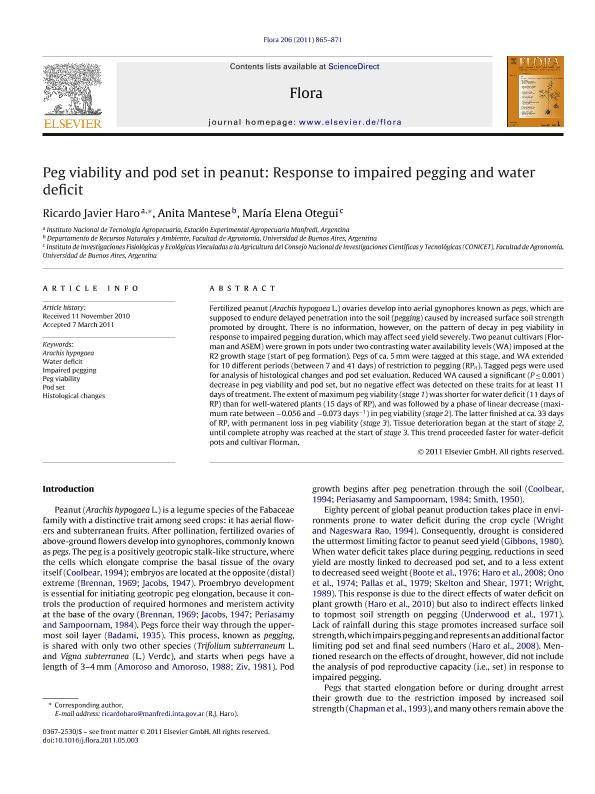Artículo
Peg viability and pod set in peanut: Response to impaired pegging and water deficit
Fecha de publicación:
10/2011
Editorial:
Elsevier Gmbh
Revista:
Flora
ISSN:
0367-2530
Idioma:
Inglés
Tipo de recurso:
Artículo publicado
Clasificación temática:
Resumen
Fertilized peanut (Arachis hypogaea L.) ovaries develop into aerial gynophores known as pegs, which are supposed to endure delayed penetration into the soil (pegging) caused by increased surface soil strength promoted by drought. There is no information, however, on the pattern of decay in peg viability in response to impaired pegging duration, which may affect seed yield severely. Two peanut cultivars (Florman and ASEM) were grown in pots under two contrasting water availability levels (WA) imposed at the R2 growth stage (start of peg formation). Pegs of ca. 5mm were tagged at this stage, and WA extended for 10 different periods (between 7 and 41 days) of restriction to pegging (RPn). Tagged pegs were used for analysis of histological changes and pod set evaluation. Reduced WA caused a significant (P≤0.001) decrease in peg viability and pod set, but no negative effect was detected on these traits for at least 11 days of treatment. The extent of maximum peg viability (stage 1) was shorter for water deficit (11 days of RP) than for well-watered plants (15 days of RP), and was followed by a phase of linear decrease (maximum rate between -0.056 and -0.073 days-1) in peg viability (stage 2). The latter finished at ca. 33 days of RP, with permanent loss in peg viability (stage 3). Tissue deterioration began at the start of stage 2, until complete atrophy was reached at the start of stage 3. This trend proceeded faster for water-deficit pots and cultivar Florman. © 2011 Elsevier GmbH.
Archivos asociados
Licencia
Identificadores
Colecciones
Articulos(IFEVA)
Articulos de INST.D/INV.FISIOLOGICAS Y ECO.VINCULADAS A L/AGRIC
Articulos de INST.D/INV.FISIOLOGICAS Y ECO.VINCULADAS A L/AGRIC
Citación
Haro Juarez, Ricardo Javier; Mantese, Anita Ida; Otegui, Maria Elena; Peg viability and pod set in peanut: Response to impaired pegging and water deficit; Elsevier Gmbh; Flora; 206; 10; 10-2011; 865-871
Compartir
Altmétricas




